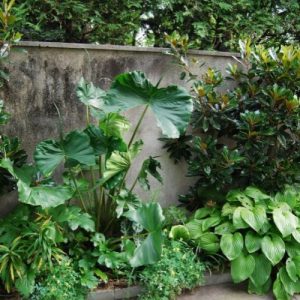Alocasia Stingray

- Botanical Name: Alocasia macrorrhiza ‘Stingray’
- Family Name: Araceae
- Stems: 10-30 inches
- Temperature: 10-28°C
- Others: Dappled light, high humidity, and moist soil
Overview
Product Description
Alocasia Stingray: The Tropical Temptress of the Green World
Roots of the Rambler – Alocasia Stingray’s Tropical Origins
Alocasia Stingray, a member of the Araceae family, originates from the lush tropical regions of South America. This plant has captured the hearts of botanists and plant enthusiasts worldwide with its distinctive leaf shape and elegant presence. The Alocasia Stingray’s natural habitat is characterized by warm temperatures and high humidity, conditions it thrives in when grown outside its native region. This fern-like plant is not just a pretty face; its large, sculptural leaves provide a dramatic accent in any garden or interior space.

Alocasia Stingray
The Balmy Preferences of the Humidity Connoisseur
As a true connoisseur of humidity, the Alocasia Stingray requires an environment that mimics the steamy climes of its tropical homeland. It flourishes under bright, indirect sunlight, which allows its large leaves to photosynthesize effectively without risk of scorching. The ideal humidity level for this plant is on the higher side, ranging from 50% to 80%, which helps maintain the succulence of its large leaves. Temperature-wise, the Alocasia Stingray prefers to stay on the cozy side, with a minimum survival temperature of 10°C and an optimal growth range of 18°C to 28°C.
The Stingray Silhouette – Morphological Marvels
The Alocasia Stingray’s most striking feature is its unique leaf shape, which has earned it the name. Its leaves start with a narrow base and extend into a long, pointed tip, much like the wings of a stingray. The broad, trailing lobes that follow the central leaf stalk further the resemblance to the marine creature. The petioles, or leaf stems, display striking brownish patterns that add to the visual appeal of this plant. Capable of growing over 100 centimeters tall, the Alocasia Stingray commands attention in any setting, whether as a statement piece indoors or a tropical accent outdoors.
The Versatile Vegetative Vixen – Adaptable and Enchanting
The Alocasia Stingray is a versatile plant that excels as an indoor specimen or as a component of outdoor landscapes in warm climates. It adds a lush, tropical feel to flower beds, borders, and woodland gardens, making it a favorite for those seeking a unique look and high ornamental value. This plant is not just about looks; it also contributes to air purification, enhancing the vitality of indoor environments with its natural filters. The Alocasia Stingray is a living piece of art that brings a touch of the tropics to any corner it occupies.
The Art of Alocasia Stingray Care
Nurturing Health with Humidity and Light
To keep your Alocasia Stingray‘s leaves from yellowing, create an environment that mimics its tropical origins. Maintain a humid atmosphere by misting, using a humidifier, or placing water dishes around the plant. Ensure it receives bright, indirect light to support photosynthesis without scorching the leaves. Avoid letting the plant sit in soggy soil, which can lead to root rot and yellowing leaves. Water when the top few centimeters of soil begin to dry, and consider using a well-draining soil mix to prevent waterlogged conditions.
Temperature Control and Nutrient Balance
Alocasia Stingray thrives in a stable climate with temperatures between 18°C to 28°C. Sudden fluctuations can stress the plant, leading to yellow leaves. Use the dial of a thermometer to keep tabs on the environment. When it comes to feeding, a balanced, water-soluble fertilizer applied sparingly during the growing season will support robust growth without the risk of over-enrichment. Additionally, keep an eye out for pests, as they can cause damage that leads to yellowing. Regularly inspect the plant, and address any infestations promptly to maintain its vibrant health.










